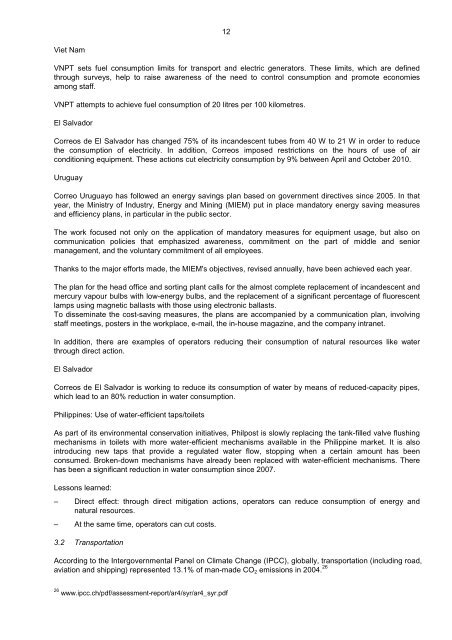ENG - UN CC:Learn
ENG - UN CC:Learn
ENG - UN CC:Learn
Create successful ePaper yourself
Turn your PDF publications into a flip-book with our unique Google optimized e-Paper software.
12<br />
Viet Nam<br />
VNPT sets fuel consumption limits for transport and electric generators. These limits, which are defined<br />
through surveys, help to raise awareness of the need to control consumption and promote economies<br />
among staff.<br />
VNPT attempts to achieve fuel consumption of 20 litres per 100 kilometres.<br />
El Salvador<br />
Correos de El Salvador has changed 75% of its incandescent tubes from 40 W to 21 W in order to reduce<br />
the consumption of electricity. In addition, Correos imposed restrictions on the hours of use of air<br />
conditioning equipment. These actions cut electricity consumption by 9% between April and October 2010.<br />
Uruguay<br />
Correo Uruguayo has followed an energy savings plan based on government directives since 2005. In that<br />
year, the Ministry of Industry, Energy and Mining (MIEM) put in place mandatory energy saving measures<br />
and efficiency plans, in particular in the public sector.<br />
The work focused not only on the application of mandatory measures for equipment usage, but also on<br />
communication policies that emphasized awareness, commitment on the part of middle and senior<br />
management, and the voluntary commitment of all employees.<br />
Thanks to the major efforts made, the MIEM's objectives, revised annually, have been achieved each year.<br />
The plan for the head office and sorting plant calls for the almost complete replacement of incandescent and<br />
mercury vapour bulbs with low-energy bulbs, and the replacement of a significant percentage of fluorescent<br />
lamps using magnetic ballasts with those using electronic ballasts.<br />
To disseminate the cost-saving measures, the plans are accompanied by a communication plan, involving<br />
staff meetings, posters in the workplace, e-mail, the in-house magazine, and the company intranet.<br />
In addition, there are examples of operators reducing their consumption of natural resources like water<br />
through direct action.<br />
El Salvador<br />
Correos de El Salvador is working to reduce its consumption of water by means of reduced-capacity pipes,<br />
which lead to an 80% reduction in water consumption.<br />
Philippines: Use of water-efficient taps/toilets<br />
As part of its environmental conservation initiatives, Philpost is slowly replacing the tank-filled valve flushing<br />
mechanisms in toilets with more water-efficient mechanisms available in the Philippine market. It is also<br />
introducing new taps that provide a regulated water flow, stopping when a certain amount has been<br />
consumed. Broken-down mechanisms have already been replaced with water-efficient mechanisms. There<br />
has been a significant reduction in water consumption since 2007.<br />
Lessons learned:<br />
– Direct effect: through direct mitigation actions, operators can reduce consumption of energy and<br />
natural resources.<br />
– At the same time, operators can cut costs.<br />
3.2 Transportation<br />
According to the Intergovernmental Panel on Climate Change (IP<strong>CC</strong>), globally, transportation (including road,<br />
aviation and shipping) represented 13.1% of man-made CO 2 emissions in 2004. 26<br />
26 www.ipcc.ch/pdf/assessment-report/ar4/syr/ar4_syr.pdf

















